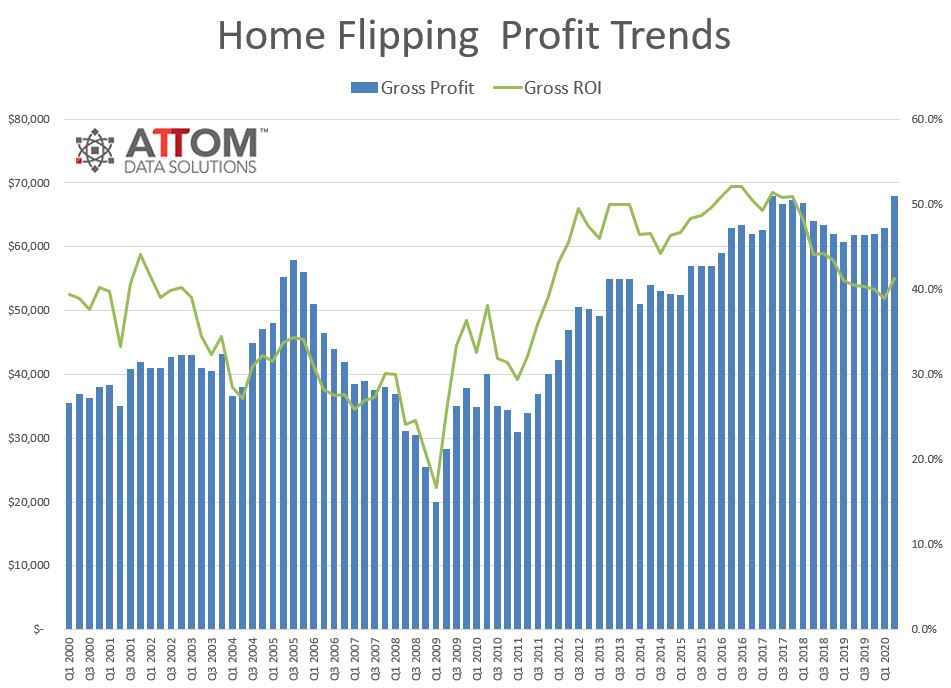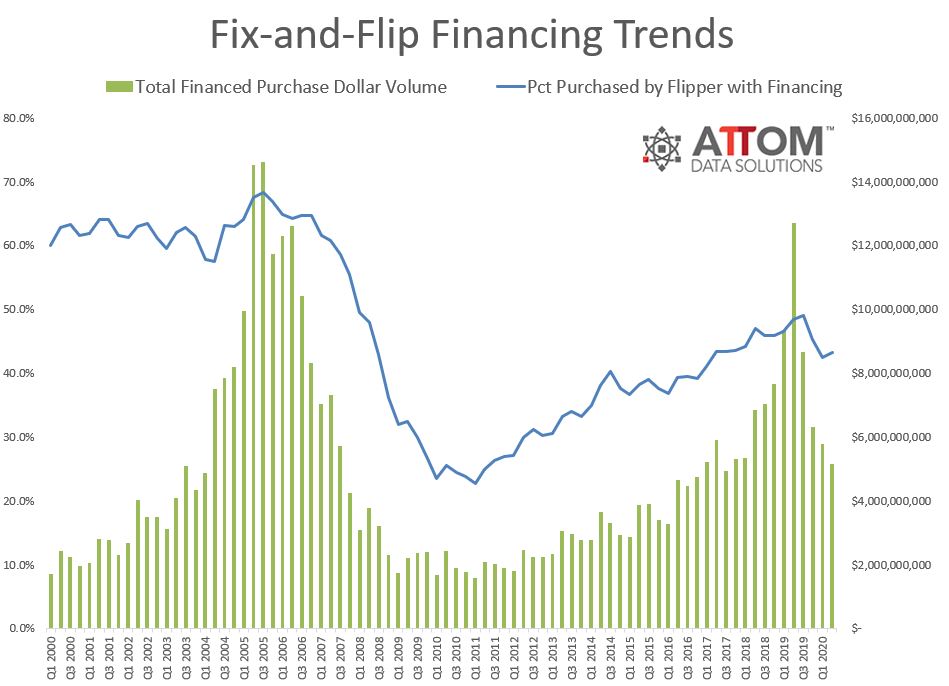
ATTOM Data Solutions, curator of the nation’s premier property database and first property data provider of Data-as-a-Service (DaaS), today released its second-quarter 2020 U.S. Home Flipping Report showing that 53,621 single-family homes and condominiums in the United States were flipped in the second quarter. Those transactions represented 6.7 percent of all home sales in the second quarter of 2020, or one in 15 transactions. That figure was down from 7.5 percent of all home sales in the nation during the prior quarter, or one in 13, but up from 6.1 percent, or one in 17 sales, in the second quarter of last year.

While the home-flipping rate dropped from the first to the second quarter, both profits and profit margins rose. The gross profit on the typical home flip nationwide (the difference between the median sales price and the median paid by investors) increased in the second quarter of 2020, to $67,902. That was up from $63,000 in the first quarter of 2020 and from $61,900 in the second quarter of last year.
The increase pushed profit margins up, with the typical gross flipping profit of $67,902 in the second quarter translating into a 41.3 percent return on investment compared to the original acquisition price. The gross flipping ROI was up from 38.9 percent in the first quarter of 2020 and 40.4 percent a year earlier. The improvement in the typical ROI marked the first quarterly increase since the third quarter of 2018 and the first year-over-year gain since the fourth quarter of 2017.

The opposing trends – the flipping rate down but profits up – came as the worldwide Coronavirus surged across the U.S., hurting sales but not prices. Home sales sank amid a combination of social distancing aimed at slowing the spread of the virus and rising unemployment connected to the pandemic’s economic impact. Yet prices rose in significant parts of the country as home seekers able and willing to take advantage of historically low mortgage rates ventured into the market and competed for a reduced supply of homes for sale.
“Home flipping was a study in contrasts in the second quarter of 2020, as the flipping rate went one way and profits went the other,” said Todd Teta, chief product officer at ATTOM Data Solutions. “Far fewer house hunters were out in the market looking for homes, which probably cut into the pool of potential buyers that investors could tap. But at the same time, home flippers who were able to close deals did better than they had done in a year and a half. That likely flowed in large part from extremely low interest rates that enticed buyers who remained employed and were willing to house-hunt within social distancing requirements.”
Home flipping rates down in three quarters of local markets
As the virus pandemic upended the Spring buying season, home flips as a portion of all home sales decreased from the first quarter to the second quarter of 2020 in 114 of the 151 metropolitan statistical areas analyzed in the report (75.5 percent). (Metro areas were included if they had at a population of 200,000 or more and at least 50 home flips in the second quarter of 2020.)
Among those metro areas, the largest quarterly decreases in the home flipping rate came in Durham, NC (rate down 40.7 percent); Provo, UT (down 36.6 percent); Boston, MA (down 35.1 percent); Denver, CO (down 33.7 percent) and Salt Lake City, UT (down 32 percent).
Aside from Boston, Denver and Salt Lake City, the biggest quarterly flipping-rate decreases in 53 metro areas with a population of 1 million or more were in Minneapolis, MN (rate down 27.6 percent) and Indianapolis, IN (down 26.5 percent).
The biggest increases in home-flipping rates were in Salisbury, MD (rate up 45.8 percent); Fort Myers, FL (up 20.2 percent); Tallahassee, FL (up 16.8 percent); Corpus Christi, TX (up 14.1 percent) and Kennewick, WA (up 12.6 percent).
Typical home flipping returns up in almost two-thirds of markets
Homes flipped in the second quarter of 2020 were sold for a median price of $232,402, with a gross flipping profit of $67,902 above the median investor purchase price of $164,500. That gross-profit figure was up from $63,000 in the first quarter of 2020 and from $61,900 in the second quarter of last year. The increase boosted the typical return on investment in the second quarter of 2020 to 41.3 percent, up from 38.9 percent in the first quarter of 2020 and from 40.4 a year ago. The ROI in the second quarter stood at its highest point since the fourth quarter of 2018, when it was 43.4 percent.
Profit margins increased from the second quarter of 2019 to the second quarter of 2020 in 95 of the 151 metro areas with enough data to analyze (62.9 percent). The biggest gains were in Fort Collins, CO (return on investment up 167 percent); Johnson City, TN (up 115 percent); Cedar Rapids, IA (up 100 percent); Youngstown, OH (up 92 percent) and Chattanooga, TN (up 91 percent).
Among metro areas with a population of at least 1 million, the biggest increases were in Milwaukee, WI (ROI up 77 percent); San Francisco (up 64 percent); Rochester, NY (up 62 percent); San Jose, CA (up 56 percent) and San Antonio, TX (up 46 percent).
The biggest year-over-year declines in investment returns during the second quarter of 2020 were in Myrtle Beach, SC (ROI down 69 percent); McAllen, TX (down 57 percent); Toledo, OH (down 53 percent); Manchester, NH (down 46 percent) and Jacksonville, FL (down 42 percent).
Investors sold for at least double their purchase price in just six percent of markets
The gross ROI on home flips in the second quarter of 2020 was at least twice the median purchase price in only nine of the 151 metro areas with enough data to analyze (6 percent).
Those markets were led by Hickory, SC (143.3 percent return, up from 82.4 percent in the second quarter of 2019); Pittsburgh, PA (135.6 percent return, up from 132.4 percent a year ago); Youngstown, OH (125 percent return, up from 65.1 percent a year ago); Springfield, IL (115.1 percent return, up from 79.4 percent a year ago) and Chattanooga, TN (105.4 percent return, up from 55.2 percent a year ago).
The smallest second-quarter 2020 profit margins on typical sales were in Raleigh, NC (11.8 percent, down from 13.8 percent in the second quarter of 2019); Myrtle Beach, SC (12.3 percent, down from 40 percent a year ago); Boise, ID (15.4 percent, down from 16.3 percent a year ago); Las Vegas, NV (18.4 percent, up from 15.2 percent a year ago) and Greeley, CO (18.5 percent, down from 25.9 percent a year ago).
Raw profits remain highest in the West and Northeast, lowest in the South
The highest second-quarter 2020 profits, measured in dollars, were concentrated in the West and Northeast. Among metro areas with enough data to analyze, 21 of the top 25 were in the those regions, led by San Jose, CA (gross profit of $305,000); Honolulu, HI ($173,500); San Francisco, CA ($173,500); New York, NY ($156,550) and San Diego, CA ($149,500).
Eighteen of the smallest 25 profits, in dollars, were spread across southern metro areas, led by Myrtle Beach, SC ($22,250 profit); Raleigh, NC ($27,250); Killeen, TX ($29,375); Lubbock, TX ($29,987) and McAllen, TX ($36,625).
Home flips purchased with financing rise while portion bought with cash dip
Nationally, the portion of flipped homes purchased with financing increased in the second quarter of 2020 to 43.3 percent, from 42.5 percent in the first quarter of 2020, but still down from 48.5 percent in the second quarter of 2019. Meanwhile, 56.7 percent of homes flipped in the second quarter of 2020 were bought with all cash, down from 57.5 percent in the prior quarter, but still up from 51.5 percent a year earlier.

Among metropolitan statistical areas with a population of 1 million or more and sufficient data to analyze, those with the highest percentage of flips purchased with financing in the second quarter of 2020 were Seattle, WA (61.5 percent); San Diego, CA (58.1 percent); San Francisco, CA (55.6 percent); Virginia Beach, VA (50.7 percent) and Hartford, CT (49.7 percent).
Average time to flip nationwide increases to 183 days
Home flippers who sold homes in the second quarter of 2020 took an average of 183 days to complete the transactions, up from an average of 174 in the first quarter of 2020 but down from 184 days in the second quarter of last year.
Percent of flipped homes sold to FHA buyers increases to highest level in three years
Of the 53,621 U.S. homes flipped in the second quarter of 2020, 15.6 percent were sold to buyers using a loan backed by the Federal Housing Administration (FHA), up from 15.2 percent in the prior quarter and from 13.8 percent in the same period a year ago, to the highest point since the second quarter of 2017.
Among the 151 metro areas with a population of at least 200,000 and at least 50 home flips in the second quarter of 2020, those with the highest percentage of home flips sold to FHA buyers — typically first-time homebuyers — were McAllen, TX (32.4 percent); Stockton, CA (32.3 percent); Bakersfield, CA (31.8 percent); Visalia, CA (31.6 percent) and El Paso, TX (29.4 percent).
Eighty-nine counties had a home flipping rate of at least 10 percent
Among 695 counties with at least 10 home flips in the second quarter of 2020, there were 89 where those transactions comprised at least 10 percent of all home sales. The top five were Franklin County (Frankfort), KY (27.8 percent); Clayton County, GA, in the Atlanta metro area (21.4 percent); Macon County, TN, in the Nashville metro area (18.6 percent); Portsmouth City/County, VA, in the Virginia Beach metro area (17.5 percent) and Craven County (New Bern), NC (16.4 percent).
Report methodology
ATTOM Data Solutions analyzed sales deed data for this report. A single-family home or condo flip was any arms-length transaction that occurred in the quarter where a previous arms-length transaction on the same property had occurred within the last 12 months. The average gross flipping profit is the difference between the purchase price and the flipped price (not including rehab costs and other expenses incurred, which flipping veterans estimate typically run between 20 percent and 33 percent of the property’s after repair value). Gross flipping return on investment was calculated by dividing the gross flipping profit by the first sale (purchase) price.
To learn more about the data behind this article and what Attom Data Solutions has to offer, visit https://www.attomdata.com/.







Sign up to receive our stories in your inbox.
Data is changing the speed of business. Investors, Corporations, and Governments are buying new, differentiated data to gain visibility make better decisions. Don't fall behind. Let us help.













Sign up to receive our stories in your inbox.
Data is changing the speed of business. Investors, Corporations, and Governments are buying new, differentiated data to gain visibility make better decisions. Don't fall behind. Let us help.





